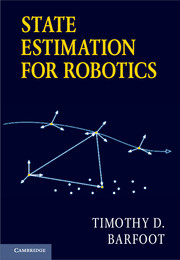1 - Introduction
Published online by Cambridge University Press: 09 August 2017
Summary
Robotics inherently deals with things that move in the world. We live in an era of rovers on Mars, drones surveying the Earth, and, soon, self-driving cars. And although specific robots have their subtleties, there are also some common issues we must face in all applications, particularly state estimation and control.
The state of a robot is a set of quantities, such as position, orientation, and velocity, that, if known, fully describe that robot's motion over time. Here we focus entirely on the problem of estimating the state of a robot, putting aside the notion of control. Yes, control is essential, as we would like to make our robots behave in a certain way. But the first step in doing so is often the process of determining the state. Moreover, the difficulty of state estimation is often underestimated for real-world problems, and thus it is important to put it on an equal footing with control.
In this book, we introduce the classic estimation results for linear systems corrupted by Gaussian measurement noise.We then examine some of the extensions to nonlinear systems with non-Gaussian noise. In a departure from typical estimation texts, we take a detailed look at how to tailor general estimation results to robots operating in three-dimensional space, advocating a particular approach to handling rotations.
The rest of this introduction provides a little history of estimation, discusses types of sensors and measurements, and introduces the problem of state estimation. It concludes with a breakdown of the contents of the book and provides some other suggested reading.
A Little History
About 4,000 years ago, the early seafarers were faced with a vehicular state estimation problem: how to determine a ship's position while at sea. Early attempts to develop primitive charts and make observations of the sun allowed local navigation along coastlines. However, it was not until the fifteenth century that global navigation on the open sea became possible with the advent of key technologies and tools. The mariner's compass, an early form of the magnetic compass, allowed crude measurements of direction to be made. Together with coarse nautical charts, the compass made it possible to sail along rhumb lines between key destinations (i.e., following a compass bearing).
Information
- Type
- Chapter
- Information
- State Estimation for Robotics , pp. 1 - 6Publisher: Cambridge University PressPrint publication year: 2017
